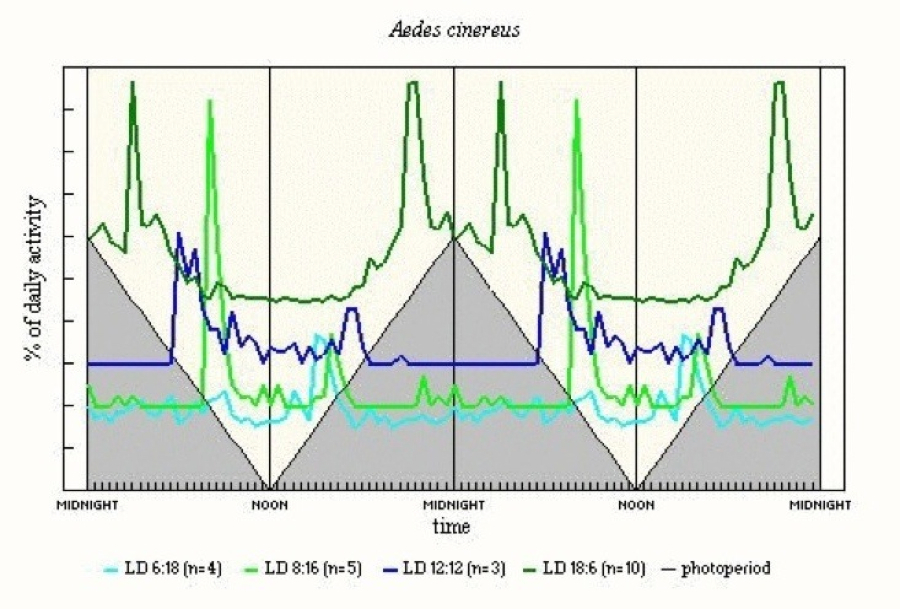
Biological Clocks in Mosquitoes - Section 2
Comparative analysis of the patterns of flight activity under various
photoperiods - Early (strong light) crepuscular species
|
(i) Aedes cinereus
A forest species of the northern Holarctic region, found up to 69°N and
south to around 45°N in Europe and 35°N in the USA. Figure 9 shows the
photoperiodogram. The results, although not very satisfactory, perhaps
due to the low numbers of adults, show a bimodal E' and M' with
activity spanning the light-dark transition. This suggests a true
crepuscular pattern, as E' and M are strong and
diffuse in LD 18:6. E' appears to follow light-on by some
14-16h and there is a small peak in D when L < 8h. Such
entrainment would account for the very pronounced E' in LD
18:6.
Figure 9

(ii) Aedes punctor
A northern Holarctic species, found up to the northern limits of land
in Europe, 71°N, and south to about 45°N in Europe and in the Americas
slightly further south, 40°N. Figure 10 shows the photoperiodogram. The
dominant pattern is bimodal with E and M peaks.
Notably, in the mid-range LD regimes, there are low levels of activity
both building up to and declining from the main activity in the
half-hour E and M peaks. Although the immediate
post-light-on M peak is not present in LD 6:18 and LD 4:20,
there is a surge of activity around 12-13h after light-off; this also
can be seen at a lower level in the regimes with L > 16h. The form
of the E and M peaks in mid-range LD regimes suggests
a truly crepuscular pattern of activity and the light intensity used,
70 lux, is of the same order as that when activity started during the
field catches.
Figure 10

Discussion
These patterns are characterised by sharp peaks but with the onset and
cessation of activity coming either side of the change in light
intensity.
The Ae. cinereus results (see Figure 9) were obtained with
only a few individuals and for only four LD regimes. Nevertheless, the
pattern in LD 18:6 suggests an E'-E intermediate peak, starting
some 15h after light-on, and an M'-M peak, with its apex some
6-8h after the previous light-off. The E'-E peak is diminished
in the shorter L regimes.
With the much more comprehensive Ae. punctor results
(see Figure 10), M'-M can be seen as anticipated in the long D
regimes, and being pronounced in the long L regimes. E'-E
activity seems to be entrained primarily by the previous light-off, as
the commencement of activity is about 1h before light-off in all LD
regimes. In LD 20:4 and LD 22:2, however, there is a rise or small peak
around 18h after light-on.
 NEXT
NEXT

©1998, 2010 - Brian Taylor CBiol FSB FRES
11, Grazingfield, Wilford, Nottingham, NG11 7FN, U.K.
Comments to dr.b.taylor@ntlworld.com
|
href="\crhtml\ppgram4.htm"



